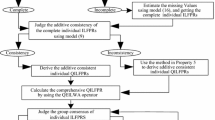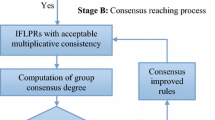Abstract
Deriving the “closest” (minimal distance) collective judgment to all individual opinions is a complex aggregation problem that has been widely studied in group decision-making literature. However, most of the existing literature does not consider individual opinions expressed as partial preorders (i.e., a preference system which includes the incomparability relation). In this paper, we propose a method based on binary linear programming to derive a minimum distance-based collective preorder from individual preferences relational systems (p.r.s.). This method is threefold. First, each member determines a preorder (partial or total) over the set of alternatives. Second, an aggregation algorithm is proposed to derive at least one collective and not necessary transitive p.r.s. at minimum distance from all individual preorders. Third, a binary linear programming optimization will transform each non-transitive collective p.r.s. into a collective preorder (i.e. a transitive p.r.s.). The proposed method has three main advantages: (1) it deals with incomparability (partial preorders), (2) the relative importance of the members is explicitly considered and (3) the collective p.r.s. obtained after the aggregation step might be “exploited” according to different decision-making problematics (i.e. ranking, choice and sorting).
Similar content being viewed by others
References
Arrow KJ (1951) Social Choice and individual values. Wiley, New York
Ben Abdelaziz F, Martel JM, Mselmi A (2004) IMGD: an interactive method for multi-objective group decision aid. J Oper Res Soc 55(5): 464–474
Ben Khélifa S, Martel JM (2001) A distance-based collective weak ordering. Group Decis Negotiat 10: 317–329
Banzhaf JF (1965) Weighted voting Doesn’t Work: a mathematical analysis. Rutgers Law Rev 19: 317–343
Borda JC (1781) Mémoire sur les Élections au Scrutin. Histoire de l’Académie Royale de Science, Paris
Brans JP, Mareschal B, Vincke Ph (1984) PROMETHEE: a new family of outranking methods in multicriteria analysis. In: Brans JP (eds) Operational research’84. North-Holland, Amsterdam, pp 408–421
Condorcet (Marquis de) MJANC (1785) Essai sur l’application de l’analyse à la probabilité des décisions rendues à la pluralité des voies. Imprimante Royale, Paris
Cook WD, Seiford LM (1978) Priority ranking and consensus formation. Manag Sci 24: 1721–1733
Cook WD, Kress M (1985) Ordinal ranking with intensity of preference. Manag Sci 31: 26–32
Cook WD, Kress M, Seiford LM (1986) An axiomatic approach to distance on partial orderings. RAIRO Recherche Opérationnelle 20: 115–122
Cook WD (2006) Distance-based and ad hoc consensus models in ordinal preference ranking. Eur J Oper Res 172: 369–385
Copeland H (1951) A reasonable social choice welfare function. Seminar on application of mathematics to social sciences. University of Michigan
Deegan J, Packel EW (1979) A new index of power for simple n-person games. Int J Game Theory 7: 113–123
DeGroot M (1974) Reaching a consensus. J Am Stat Assoc 69: 118–121
Figueira J, Roy B (2002) Determining the weights of criteria in the ELECTRE type methods with a revised Simos’ procedure. Eur J Oper Res 139: 317–326
French JRP (1956) A formal theory of social power. Psychol Rev 63(3): 181–194
Hudry O, Leclerc B, Monjardet B, Barthélemy J-P (2005) Médianes métriques et laticielles. In: Dubois D, Pirlot M, Bouyssou D, Prade H (eds) Concepts et méthodes pour l’aide à la décision 2005
Jabeur K, Martel JM (2002a) Détermination d’un (ou plusieurs) systèmes(s) relationnel(s) de préférence (s.r.p) collectif(s) à partir des s.r.p. individuels. Document de travail # 011-2002, Faculté des Sciences de l’Administration (FSA), Université Laval
Jabeur K, Martel JM (2002b) Quantification de l’importance relative des membres d’un groupe en vue d’établir un préordre collectif. Info Syst Oper Res 40: 81–198
Jabeur K, Martel JM, Ben Khélifa S (2004) A distance-based collective preorder integrating the relative importance of the group’s members. Group Decis Negotiat 13: 327–349
Jabeur K (2004) Une démarche générale d’aide aux membres d’un groupe à la recherche d’un résultat de consensus. Ph.D. thesis, Université Laval, Canada
Jabeur K, Martel J-M (2007a) A collective choice method based on individual preferences relational systems (p.r.s). Eur J Oper Res 177: 1549–1565
Jabeur K, Martel J-M (2007b) An ordinal sorting method for group decision-making. Eur J Oper Res 180: 1272–1289
Keeney RL, Kirkwood CW (1975) Group decision making using cardinal social welfare functions. Manag Sci 22: 430–437
Keeney RL, Raiffa H (1976) Decision with multiple objectives: preferences and value tradeoffs. Wiley, New York
Kemeny JG, Snell JL (1962) Preference ranking: an axiomatic approach. Mathematical models in the social sciences, pp 9–23
Martel JM, Ben Khélifa S (2000) Deux propositions d’aide multicritère à la décision de groupe. In: Ben Abdelaziz, Haouari et Mellouli (eds) Optimisation et Décision. Centre de publication Universitaire, Tunis, pp 213–228
Pomerol J-C, Barbara-Romero S (1993) Choix multicritère dans l’entreprise: principe et pratique. Collection informatique, Éditions Hermes
Ramanathan R, Ganesh LS (1994) Group preference aggregation methods employed in AHP: an evaluation and an intrinsic process for deriving members’ weightages. Eur J Oper Res 79: 249–265
Roy B (1978) ELECTRE III: Algorithme de Classement Basé sur une Représentation des Préférence en Présence de Critères Multiples. Cahiers du CERO 21: 3–24
Roy B, Bouyssou D (1993) Aide multicritère à la décision: méthodes et cas. Economica, Paris
Roy B, Slowinski R (1993) Criterion of distance between technical programming and socio-economic priority. RAIRO Recherche Opérationnelle 27(1): 45–60
Shapley LS, Shubik M (1954) A method for evaluating the distribution of power in a committee system. Am Political Sci Rev 48(3): 787–792
Schärlig A (1996) Pratiquer Électre et Prométhée. Collection Diriger l’entreprise, Presses polytechniques et universitaires romandes, Lausanne
Vincke P (1989) L’aide multicritère à la décision. Éditions de l’Université de Bruxelles, Belgique
Author information
Authors and Affiliations
Corresponding author
Rights and permissions
About this article
Cite this article
Jabeur, K., Martel, JM. & Guitouni, A. Deriving a minimum distance-based collective preorder: a binary mathematical programming approach. OR Spectrum 34, 23–42 (2012). https://doi.org/10.1007/s00291-009-0192-5
Published:
Issue Date:
DOI: https://doi.org/10.1007/s00291-009-0192-5




